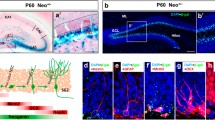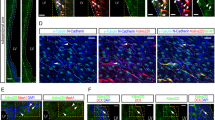Abstract
Neurogenesis in the dentate gyrus (DG) of the adult hippocampus is actively involved in brain homeostasis. Thus, identification of novel regulators in adult neurogenesis could significantly contribute to new therapies. We have recently unraveled the regulatory role of NR5A2 (also known as LRH1), a druggable orphan nuclear receptor, in embryonic neurogenesis. However, its involvement in adult neurogenesis is still an open question. Here we show that NR5A2 is differentially expressed in the DG of the adult hippocampus with neurons exhibiting higher levels of expression than adult neural stem/progenitor cells (aNSCs), suggesting a correlation with neuronal differentiation. Notably, NR5A2 overexpression in ex vivo cultured aNSCs induces expression of Prox1, a critical regulator of adult hippocampal neurogenesis. In agreement, NR5A2 is sufficient to reduce proliferation, increase neuronal differentiation, and promote axon outgrowth. Moreover, depletion of NR5A2 in DG cells in vivo caused a decrease in the number of NeuN as well as Calbindin-positive neurons, indicating its necessity for the maintenance of neuronal identity. Our data propose a regulatory role of NR5A2 in neuronal differentiation and fate specification of adult hippocampal NSCs.





Similar content being viewed by others
References
Altman J, Das GD (1965) Autoradiographic and histological evidence of postnatal hippocampal neurogenesis in rats. J Comp Neurol 124:319–335
Kuhn HG, Dickinson-Anson H, Gage FH (1996) Neurogenesis in the dentate gyrus of the adult rat: age-related decrease of neuronal progenitor proliferation. J Neurosci 16:2027–2033
Eriksson PS, Perfilieva E, Bjork-Eriksson T, Alborn AM, Nordborg C et al (1998) Neurogenesis in the adult human hippocampus. Nat Med 4:1313–1317
Seri B, Garcia-Verdugo JM, McEwen BS, Alvarez-Buylla A (2001) Astrocytes give rise to new neurons in the adult mammalian hippocampus. J Neurosci 21:7153–7160
Lugert S, Basak O, Knuckles P, Haussler U, Fabel K, Götz M, Haas CA, Kempermann G et al (2010) Quiescent and active hippocampal neural stem cells with distinct morphologies respond selectively to physiological and pathological stimuli and aging. Cell Stem Cell 6:445–456
Steiner B, Klempin F, Wang L, Kott M, Kettenmann H, Kempermann G (2006) Type-2 cells as link between glial and neuronal lineage in adult hippocampal neurogenesis. Glia 54:805–814
Kempermann G, Song H, Gage FH (2015) Neurogenesis in the adult hippocampus. Cold Spring Harb Perspect Biol 7:a018812
Zhao C, Teng EM, Summers RG Jr, Ming GL, Gage FH (2006) Distinct morphological stages of dentate granule neuron maturation in the adult mouse hippocampus. J Neurosci 26:3–11
van Praag H, Schinder AF, Christie BR, Toni N, Palmer TD, Gage FH (2002) Functional neurogenesis in the adult hippocampus. Nature 415:1030–1034
Deng W, Aimone JB, Gage FH (2010) New neurons and new memories: how does adult hippocampal neurogenesis affect learning and memory? Nat Rev Neurosci 11:339–350
Horgusluoglu E, Nudelman K, Nho K, Saykin AJ (2017) Adult neurogenesis and neurodegenerative diseases: a systems biology perspective. Am J Med Genet B Neuropsychiatr Genet 174:93–112
Kang E, Wen Z, Song H, Christian KM, Ming GL (2016) Adult neurogenesis and psychiatric disorders. Cold Spring Harb Perspect Biol 8(9):a019026
Krylova IN, Sablin EP, Moore J, Xu RX, Waitt GM, MacKay JA, Juzumiene D, Bynum JM et al (2005) Structural analyses reveal phosphatidyl inositols as ligands for the NR5 orphan receptors SF-1 and LRH-1. Cell 120:343–355
Lee JM, Lee YK, Mamrosh JL, Busby SA, Griffin PR, Pathak MC, Ortlund EA, Moore DD (2011) A nuclear-receptor-dependent phosphatidylcholine pathway with antidiabetic effects. Nature 474:506–510
Benod C, Carlsson J, Uthayaruban R, Hwang P, Irwin JJ, Doak AK, Shoichet BK, Sablin EP et al (2013) Structure-based discovery of antagonists of nuclear receptor LRH-1. J Biol Chem 288:19830–19844
Burris TP, Busby SA, Griffin PR (2012) Targeting orphan nuclear receptors for treatment of metabolic diseases and autoimmunity. Chem Biol 19:51–59
Fayard E, Auwerx J, Schoonjans K (2004) LRH-1: an orphan nuclear receptor involved in development, metabolism and steroidogenesis. Trends Cell Biol 14:250–260
Gu P, Goodwin B, Chung AC, Xu X, Wheeler DA et al (2005) Orphan nuclear receptor LRH-1 is required to maintain Oct4 expression at the epiblast stage of embryonic development. Mol Cell Biol 25:3492–3505
Pare JF, Malenfant D, Courtemanche C, Jacob-Wagner M, Roy S et al (2004) The fetoprotein transcription factor (FTF) gene is essential to embryogenesis and cholesterol homeostasis and is regulated by a DR4 element. J Biol Chem 279:21206–21216
Stergiopoulos A, Politis PK (2016) Nuclear receptor NR5A2 controls neural stem cell fate decisions during development. Nat Commun 7:12230
Grgurevic N, Tobet S, Majdic G (2005) Widespread expression of liver receptor homolog 1 in mouse brain. Neuro Endocrinol Lett 26:541–547
Gofflot F, Chartoire N, Vasseur L, Heikkinen S, Dembele D, le Merrer J, Auwerx J (2007) Systematic gene expression mapping clusters nuclear receptors according to their function in the brain. Cell 131:405–418
Bookout AL, Jeong Y, Downes M, Yu RT, Evans RM, Mangelsdorf DJ (2006) Anatomical profiling of nuclear receptor expression reveals a hierarchical transcriptional network. Cell 126:789–799
Davies G, Lam M, Harris SE, Trampush JW, Luciano M, Hill WD, Hagenaars SP, Ritchie SJ et al (2018) Study of 300,486 individuals identifies 148 independent genetic loci influencing general cognitive function. Nat Commun 9:2098
Bryois J, Garrett ME, Song L, Safi A, Giusti-Rodriguez P, Johnson GD, Shieh AW, Buil A et al (2018) Evaluation of chromatin accessibility in prefrontal cortex of individuals with schizophrenia. Nat Commun 9:3121
Dong J, Wyss A, Yang J, Price TR, Nicolas A, Nalls M, Tranah G, Franceschini N et al (2017) Genome-wide association analysis of the sense of smell in U.S. older adults: identification of novel risk loci in African-Americans and European-Americans. Mol Neurobiol 54:8021–8032
Lavado A, Lagutin OV, Chow LM, Baker SJ, Oliver G (2010) Prox1 is required for granule cell maturation and intermediate progenitor maintenance during brain neurogenesis. PLoS Biol 8(8):e1000460
Karalay O, Jessberger S (2011) Translating niche-derived signals into neurogenesis: the function of Prox1 in the adult hippocampus. Cell Cycle 10:2239–2240
Karalay O, Doberauer K, Vadodaria KC, Knobloch M, Berti L, Miquelajauregui A, Schwark M, Jagasia R et al (2011) Prospero-related homeobox 1 gene (Prox1) is regulated by canonical Wnt signaling and has a stage-specific role in adult hippocampal neurogenesis. Proc Natl Acad Sci U S A 108:5807–5812
Iwano T, Masuda A, Kiyonari H, Enomoto H, Matsuzaki F (2012) Prox1 postmitotically defines dentate gyrus cells by specifying granule cell identity over CA3 pyramidal cell fate in the hippocampus. Development 139:3051–3062
Stergiopoulos A, Elkouris M, Politis PK (2014) Prospero-related homeobox 1 (Prox1) at the crossroads of diverse pathways during adult neural fate specification. Front Cell Neurosci 8:454
Bonaguidi MA, Wheeler MA, Shapiro JS, Stadel RP, Sun GJ, Ming GL, Song H (2011) In vivo clonal analysis reveals self-renewing and multipotent adult neural stem cell characteristics. Cell 145:1142–1155
Sailor KA, Schinder AF, Lledo PM (2017) Adult neurogenesis beyond the niche: its potential for driving brain plasticity. Curr Opin Neurobiol 42:111–117
Peng L, Bonaguidi MA (2018) Function and dysfunction of adult hippocampal neurogenesis in regeneration and disease. Am J Pathol 188:23–28
Kaltezioti V, Kouroupi G, Oikonomaki M, Mantouvalou E, Stergiopoulos A, Charonis A, Rohrer H, Matsas R et al (2010) Prox1 regulates the notch1-mediated inhibition of neurogenesis. PLoS Biol 8:e1000565
Kaltezioti V, Antoniou D, Stergiopoulos A, Rozani I, Rohrer H, Politis PK (2014) Prox1 regulates Olig2 expression to modulate binary fate decisions in spinal cord neurons. J Neurosci 34:15816–15831
Botrugno OA, Fayard E, Annicotte JS, Haby C, Brennan T, Wendling O, Tanaka T, Kodama T et al (2004) Synergy between LRH-1 and beta-catenin induces G1 cyclin-mediated cell proliferation. Mol Cell 15:499–509
Schoonjans K, Dubuquoy L, Mebis J, Fayard E, Wendling O, Haby C, Geboes K, Auwerx J (2005) Liver receptor homolog 1 contributes to intestinal tumor formation through effects on cell cycle and inflammation. Proc Natl Acad Sci U S A 102:2058–2062
Chalkiadaki A, Talianidis I (2005) SUMO-dependent compartmentalization in promyelocytic leukemia protein nuclear bodies prevents the access of LRH-1 to chromatin. Mol Cell Biol 25:5095–5105
Venteclef N, Haroniti A, Tousaint JJ, Talianidis I, Delerive P (2008) Regulation of anti-atherogenic apolipoprotein M gene expression by the orphan nuclear receptor LRH-1. J Biol Chem 283:3694–3701
Venteclef N, Jakobsson T, Ehrlund A, Damdimopoulos A, Mikkonen L, Ellis E, Nilsson LM, Parini P et al (2010) GPS2-dependent corepressor/SUMO pathways govern anti-inflammatory actions of LRH-1 and LXRbeta in the hepatic acute phase response. Genes Dev 24:381–395
Rampias T, Vgenopoulou P, Avgeris M, Polyzos A, Stravodimos K, Valavanis C, Scorilas A, Klinakis A (2014) A new tumor suppressor role for the Notch pathway in bladder cancer. Nat Med 20:1199–1205
Papadopoulos VE, Nikolopoulou G, Antoniadou I, Karachaliou A, Arianoglou G, Emmanouilidou E, Sardi SP, Stefanis L et al (2018) Modulation of beta-glucocerebrosidase increases alpha-synuclein secretion and exosome release in mouse models of Parkinson’s disease. Hum Mol Genet 27:1696–1710
Acknowledgments
We would like to thank Daphne Antoniou, Valeria Kaltezioti, Aristidis Charonis Elpinickie Ninou, and Artemis Michail for useful discussions and advices. We also thank Apostolos Klinakis and Evangelia Chavdoula for providing Adeno-Cre viruses, Pavlos Alexakos for help and guidance with animal handling, and Stamatis Pagakis and Biological Imaging Unit of BRFAA for help and guidance in image analysis.
Funding
This research is co-financed by Greece and the European Union (European Social Fund—ESF) through the Operational Programme «Human Resources Development, Education and Lifelong Learning» in the context of the project “Strengthening Human Resources Research Potential via Doctorate Research” (MIS-5000432), implemented by a State Scholarships Foundation (ΙΚΥ) PhD studentship to MT. This research work was also supported by Fondation Sante grant and the Hellenic Foundation for Research and Innovation (H.F.R.I) under the “First Call for H.F.R.I Research Projects to support Faculty members and Researchers and the procurement of high-cost research equipment grant” (Project Number: 1782) to PKP.
Author information
Authors and Affiliations
Corresponding author
Ethics declarations
Conflict of Interest
The authors declare that they have no conflict of interest.
Ethics Approval
The experimental protocols were approved by the ethics committee (Athens Prefecture Veterinarian Service; K/3237/11-05-2012) and performed in the Center of Experimental Surgery of the Biomedical Research Foundation of the Academy of Athens. Mice were treated according to the standards of the animal practice of the Office of Laboratory Animal Welfare-NIH and Greek animal welfare bodies.
Consent to Participate
Not applicable.
Code Availability
Not applicable.
Additional information
Publisher’s Note
Springer Nature remains neutral with regard to jurisdictional claims in published maps and institutional affiliations.
Supplementary Information
Supplementary Figure 1.
Negative control for NR5A2 immunostainings. Immunostaining against NR5A2 on the 8-week-old murine DG without primary antibody. Cell nuclei were labelled with DAPI (blue). Scale bar, 250 μm (PNG 2062 kb).
Rights and permissions
About this article
Cite this article
Tsampoula, M., Tarampoulous, I., Antoniadou, I. et al. Nuclear Receptor NR5A2 Promotes Neuronal Identity in the Adult Hippocampus. Mol Neurobiol 58, 1952–1962 (2021). https://doi.org/10.1007/s12035-020-02222-8
Received:
Accepted:
Published:
Issue Date:
DOI: https://doi.org/10.1007/s12035-020-02222-8




